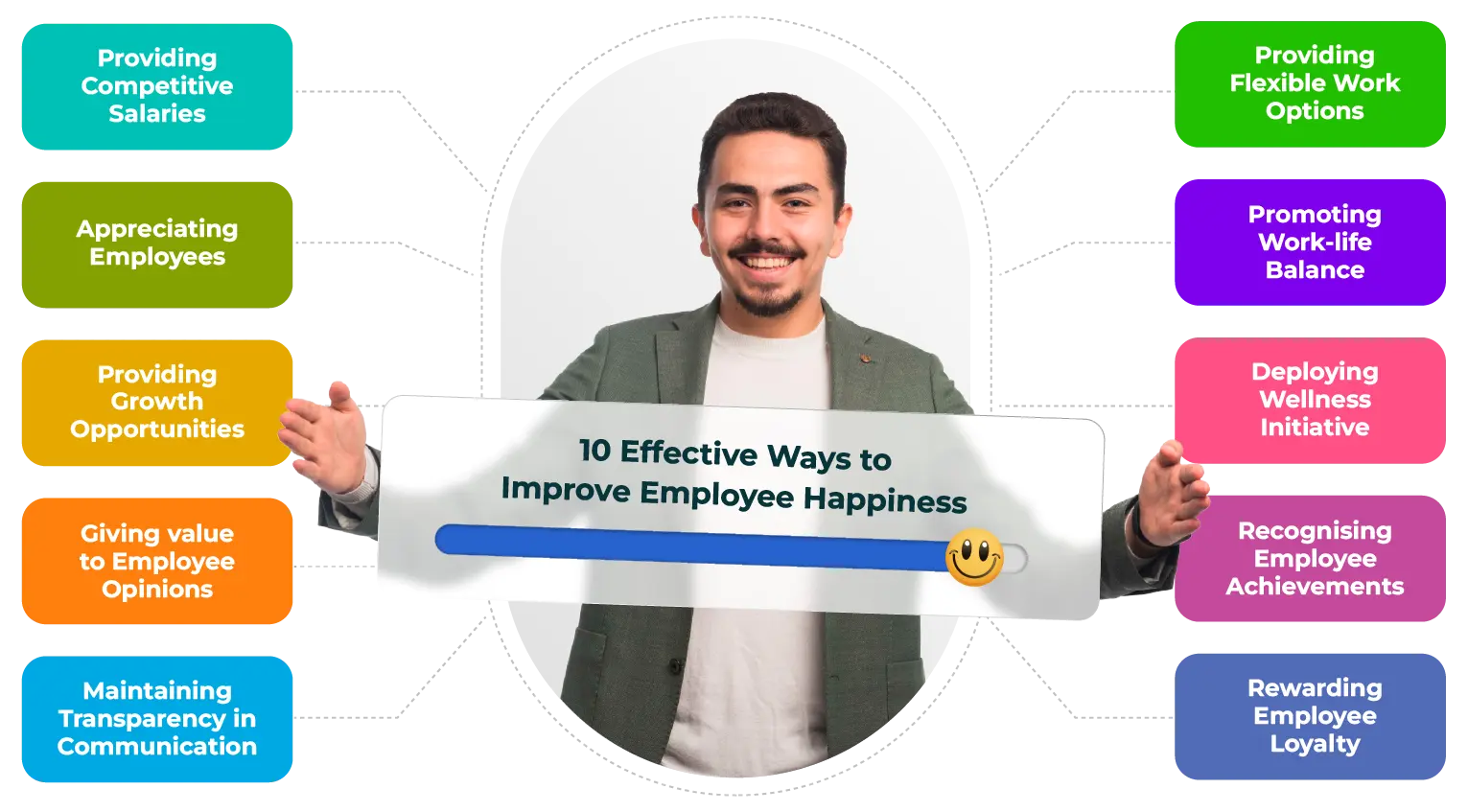
Employee Happiness: 7 Proven Ways to Boost It
Table of Contents

Reading Time: 9 minutes
Employee happiness and satisfaction are two factors of employee engagement that are critical for managing and retaining the staff of any organization, including yours. Having a happy workforce not only benefits your organization in developing a positive work environment but also helps you build a successful business. Hence, you would be already spending on lavish parties and in-house benefits to ensure the happiness of your employees.
However, is it enough? To answer this query, we will be sharing all the benefits of ensuring employee happiness in your organization while discussing 10 of the most effective ways to improve employee happiness in your company. We will also help you understand the relevance HRs play in ensuring it, while also providing steps to measure it effectively.
What is Employee Happiness?
Employee happiness is the overall positive emotional state an employee feels while at work, due to several factors such as a satisfactory work environment, engagement with the company, and positive mental well-being.
Employee happiness enables them to stay positive and have a positive outlook towards their work. It encourages them to come to their office and undertake their work to the best of their abilities.
Various factors influence the happiness of employees in their workplace, such as:
- Positive work environment
- Alignment with organizational goals
- Relationships with colleagues
- Recognition in the workplace
- Appreciation for their work
- Available growth opportunities
- Work-life balance.
10 Effective Ways to Improve Employee Happiness
Let us check 10 effective ways to improve employee happiness in your workplace:

1. Providing Competitive Salaries
While providing competitive wages is essential for employee happiness, modern organizations should go beyond and add incentives such as performance-based bonuses, profit-sharing, and even stock options, to provide their employees with a complete package. Such additional bonuses encourage the staff members to push further and stay engaged with their organization.
Additionally, they should also provide non-monetary benefits such as retirement plans, child-care reimbursements, tuition reimbursements, pet insurance, gym memberships, food coupons, etc. for a complete package. Such benefits highlight the relevance of an employee for the company, encouraging them to stay longer with an organization that values them on a professional and personal level.
2. Appreciating Employees
As human beings, we crave appreciation, and the same holds true for employees. Appreciation is critical in keeping your employees motivated and engaged with their work. It enables them to feel good about being a contributing member of the organization. Hence, it is essential to recognize and appreciate your staff for their hard work.
You can appreciate your employee through several ways such as verbally appreciating them in front of everyone, emailing the team, or even emailing the company enumerating their contributions. By recognizing your staff, you are not only motivating them to stay longer but also encouraging others to work harder for the appreciation.
3. Providing Growth Opportunities
By providing growth opportunities, you are effectively displaying your trust in them as well as their loyalty. You can provide multiple career growth options for your employees in the form of mentorships, cross-skilling, workshops, conferences, etc.
All these growth opportunities help your employees realize that you are investing in their skill sets as you understand their value for the organization. As a result, they tend to remain engaged with your company for longer. It also leads to better job satisfaction as they will be skilled to undertake their tasks better. On the other hand, it enables you to easily undertake succession planning, resulting in a solution where everyone benefits.
4. Giving value to Employee Opinions
Employees often feel that their dialogue with the company is often a one-way conversation where HRs, on behalf of their organization, speak what the management wants them to speak. However, if you provide them with a voice to speak for themselves, they can provide you with multiple invaluable insights. They can even share their ideas to improve the workplace and the processes, resulting in a better workspace.
By giving your employees a chance to voice their opinions, you are helping them feel respected and valued to be a part of your company. It leads to a happy workplace, which results in improved engagement and retention.
5. Maintaining Transparency in Communication
Similarly, transparent communication is another critical factor in ensuring the happiness of your employees. When you encourage open communication, employees will be able to speak their minds, enabling you to understand them better. It also improves intra-team collaborations, resulting in an efficient workplace.
Additionally, open communication also helps develop a sense of belonging and trust for your company. Once employees understand that you are open about company policies, goals, and processes, they will be willing to align themselves with your organization. It leads to a positive workplace, where employees value and respect each other.
6. Providing Flexible Work Options
Another major step towards improving your employees’ happiness is to provide flexible work options. While we have already witnessed the rise of remote and hybrid working options, many companies have yet to embrace complete flexibility. While many positions require a fixed timeframe, there are many other positions within an organization that can remain flexible with time and location.
Companies should provide their employees with flexibility of time and location to undertake their work, as it would result in increased productivity. By providing autonomy in working, you are also displaying your trust and commitment towards your employees, which helps in improving their engagement with your organization.
7. Promoting Work-life Balance
Work-life balance is essential for modern employees and hence, companies should promote it with their policies. It is another crucial factor for improving employee happiness as it enables them to enjoy their life while fulfilling their professional commitments. You can encourage your staff to take breaks and vacations to rejuvenate themselves.
Similarly, you can provide your employees with remote working options, as well as mental wellness programs, gyms, yoga rooms, etc. which enables them to relieve their work-related stress. You can also instruct your managers and supervisors to not disturb your staff during non-working hours, which also helps them separate their personal and professional lives.
8. Deploying Wellness Initiative
Companies can also introduce employee mental wellness programs alongside their physical wellness initiatives to improve employee happiness at work. While you should keep on motivating your staff for physical fitness, focusing on mental well-being enables them to stay loyal towards their company as they realize their value for your organization.
It is essential to note that both the physical and mental well-being of the employees should be prioritized when considering well-being options. So, while you may be providing gym memberships or sports championships, you can also organize mental well-being programs and provide psychological help whenever required, while also ensuring a stress-free environment.
9. Recognising Employee Achievements
While rewards and recognition are essential for motivating employees, recognizing their personal achievements gives a whole new dimension to it. It makes the employees extremely happy when they realize that their organization appreciates their achievements and is happy to share them with the world. It also puts the limelight directly on you, as you would be recognized as an organization that truly values its staff members.
Hence, you should celebrate your employees’ achievements such as their career milestones, work anniversaries, major certifications, etc. You can also take it a step further by rewarding them with gifts for their achievements, which will also serve as an incentive for others to follow in their path and excel at their careers.
10. Rewarding Employee Loyalty
Every company loves employees who stay with them for longer; however, only a few provide incentives for staying back or any rewards for staying with their organization for longer. To ensure employee happiness, you should also consider developing long-term commitment appreciation through rewards and recognition. For example, you can provide exclusive benefits for employees who have been working for a specific number of years in your company.
By recognizing and rewarding tenured employees, you will also be motivating others to stay longer with your organization. It also creates a sense of belonging to a ‘family’ and encourages them to stay engaged with their organization, despite their long years with the company.
What are the Benefits of Employee Happiness?
By improving employee happiness in the workplace, you can reap multiple benefits, such as having a positive work environment where productivity peaks over everything else. It leads to better quality products and services, resulting in improved branding. Additionally, happy employees also help attract and retain the best talent, ensuring organizational success.
Some of the other major benefits of employee happiness are:
➔ Increased Engagement
Happy employees actively engage with their company. Since happier employees identify with their organization and are happy about being a part of it, they actively participate in their company’s activities and provide feedback. They undertake their work diligently and ensure that the required targets are met, without external input. They may not even need a chatbot for employee engagement.
➔ Enhanced Creativity
It is proven that happiness boosts creativity and the same fact applies to the workplace. Happy employees have increased enthusiasm and energy to undertake their tasks. They take an active interest in collaborating on tasks, which also increases their creativity. Hence, employee happiness helps improve creativity, resulting in enhanced innovation.
➔ Better Client Handling
Happy employees also lead to happy clients and customers as they are engaged with the company and hence, care about the business. Since they are happy, they share that happiness with your customers, resulting in friendly and caring customer service. It also results in healthy client relationships, leading to overall organizational success in the business.
➔ Increased Retention Rate
Staff members often switch companies in search of an organization that can provide job satisfaction and keep them engaged. Conversely, employees stay longer with a company when they are happy and satisfied with their organization. Employees who stay longer with your organization will be able to undertake their tasks better as they are accustomed to your organization, resulting in enhanced productivity too.
➔ Stress-free Workplace
Happy workers are likely to spread their enthusiasm in their work, ensuring increased quality of services and products. It helps improve the quality of workplace culture by creating a sense of camaraderie, while also improving the overall enthusiasm of the teams working in the company. As a result, having happy workers helps you create a stress-free environment for the employees.
What is the role of HR in ensuring Employee Happiness?
HR is the department responsible for managing the employees of an organization. Hence, they are required to keep them satisfied and happy. While it is easier said than done, the HR team can take specific robust steps to ensure their employees’ satisfaction and happiness. By developing a positive environment and enabling an overall better work culture that encourages work-life balance, the HR team can easily make their employees happy, while attracting and retaining talented staff members.
Similarly, they should also ensure that their employees feel valued and a part of the team. They should also reward and recognize their staff along with frequent feedback to help their employees understand their importance to their company.
How to measure Employee Happiness?
Since employee happiness is critical to the workplace, HR teams should have the right tools to measure it accurately. They should be well equipped to evaluate it effectively and make changes in their strategies if required. Since happiness is not a tangible entity, HRs can take the help of employee surveys in their employee management system to measure the happiness of their employees.
There are multiple kinds of employee survey tools available, which can help you understand your employees’ mindset and make any changes to ensure their happiness. These surveys can be used for fulfilling various objectives related to employee happiness in the workplace.
For example, you can utilize employee surveys to understand the following aspects of employees’ outlook towards your workplace:
- How satisfied they are with your workplace and HR policies?
- What are the stress-inducing tasks or aspects of their work?
- How effective are the leaders and what would they like to change?
- What benefits and perks would they like to have?
- Which tools would they like to use to improve their productivity?
- What kind of career development opportunities are they looking for?
- How satisfied are they with their office amenities?
You should also make changes to your workplace and act on the feedback received via these surveys to ensure that your employees understand that you are taking active steps to improve their quality of life in the workplace.
Conclusion
Employee happiness is a simple concept to understand. However, you should take concrete and strategic steps to ensure that employees remain happy during their tenure with your organization. As we discussed in this blog, there are multiple benefits to keeping your employees happy with your organization. Hence, we urge you to implement the 10 options provided in this blog to improve your employees’ happiness index, ensuring a productive, satisfied, and happy workforce.
FAQs on Employee Happiness
1. Is salary the most important factor in Employee Happiness?
While salary is one of the most important factors of employee happiness, it is not the most important one. Happiness is defined differently by different employees; while it can be solely money for some, others consider having a healthy lifestyle to being happy.
2. Does having a wellness program improve Employee Happiness?
Having a wellness program helps your employees relieve their stress and provides them with meaningful options to avoid stressful environments. Hence, it does improve employee happiness by providing them with the exact steps to reduce anxieties in their life and live a better life.
3. How does Employee Happiness impact productivity?
Happy employees are the most productive in any company as they can better appreciate their organization and their company’s efforts in ensuring their well-being. Hence, happier employees often display higher efficiency in their work, while staying motivated to undertake their work.
4. Does remote work make Employees Happier?
Remote work does contribute towards employee happiness as it provides them with the freedom to work from the location of their choosing. It helps them undertake their task when they deem fit, while also avoiding the hassle of travelling daily to and from the office.
5. What role does career growth play in Employee Happiness?
Career growth impacts employee happiness positively since it creates a sense of purpose and motivates employees to remain satisfied and engaged with their organization. When organizations actively promote career growth initiatives, they feel valued and hence, stay with the organization for longer.







